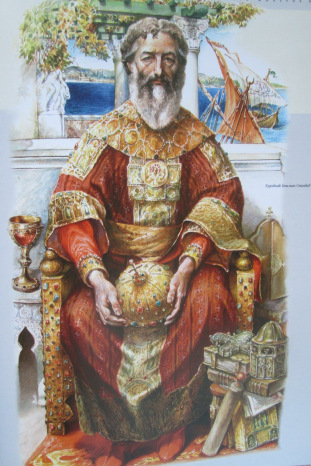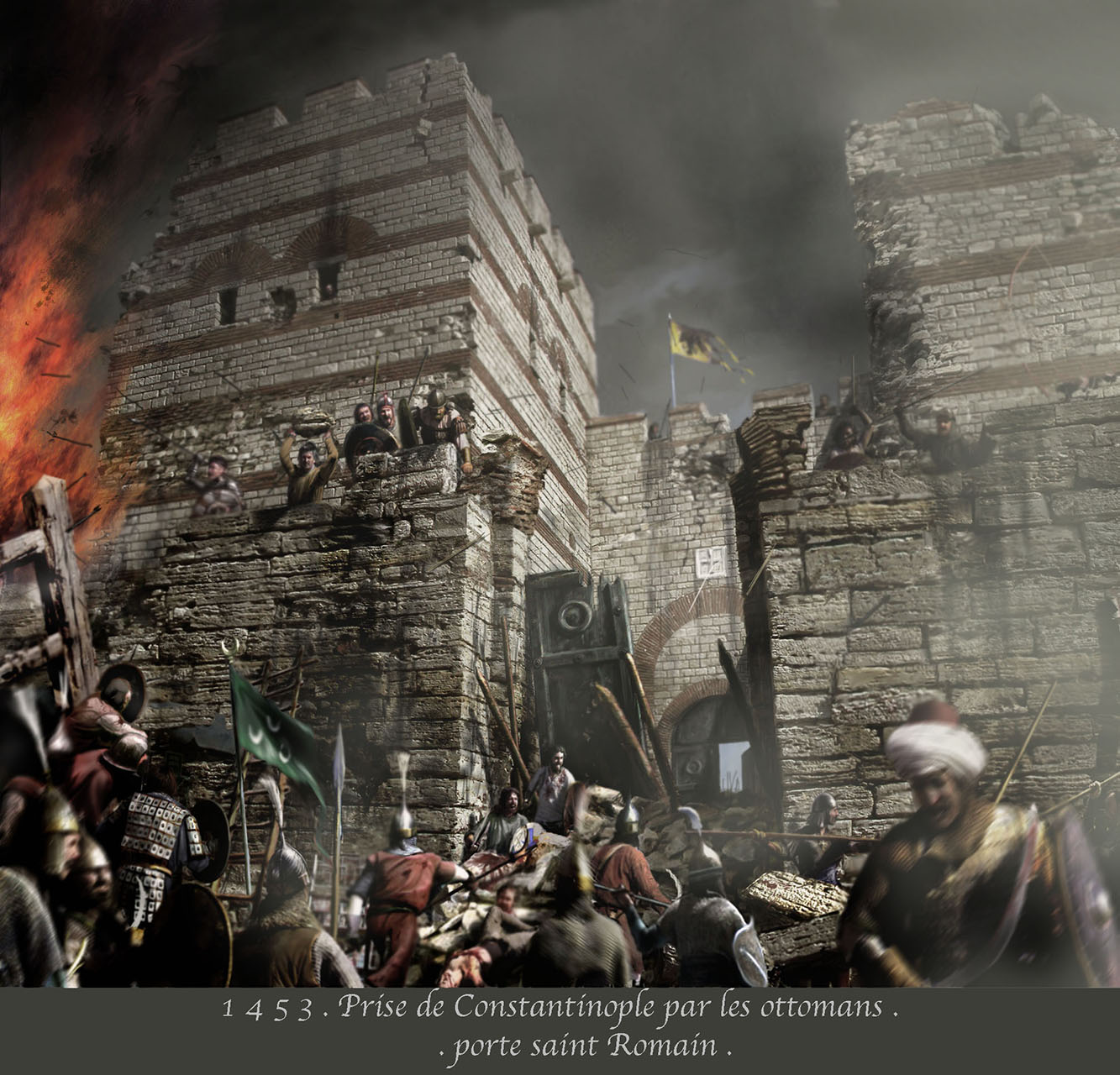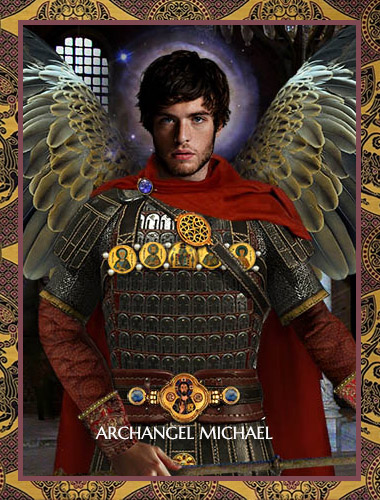
Manuel II Paleologus - traveled to London and Paris to get help to save the empire. The Muslim Turks thought he looked like the Prophet Mohammed. Married very late and had 9 children, including the twilight emperor, Constantine - the Last.

BY EDWIN PEARS, LL.B.
Manuel was with the Turkish army at Brousa when he learned the death of his father in 1391. He escaped secretly, hastened to Constantinople, and succeeded in being proclaimed as the sole occupant of the imperial throne. Bajazed, who had become sultan on the assassination of his father, Murad, in 1389, taken by surprise at the escape of his hostage, at once presented alarming demands. He asked that the Turks should have a resident cadi within Constantinople itself and that Manuel should declare himself to be the sultan’s vassal and pay tribute. After a year of fruitless negotiations, which Manuel had protracted in order that he might send to the West to implore aid, Bajazed attacked the empire on every side. Within a few months Turks were pillaging the Adriatic coast, were exterminating or carrying off prisoners from Thrace, and were laying siege to the capital. Their leader before the city urged the citizens to declare for Manuel’s nephew, John, the son of Andronicus, who had, indeed, been compelled by Bajazed to come forward as a pretender. In 1395 John joined the Turks in attacking the capital, but was defeated. The Turkish leader returned across the Bosporus, strengthened his position on the Gulf of Ismidt, by building a castle or fortress, probably the one now seen at Guebseh, and another on the Bosporus known as Guzel-hissar, and then once more summoned Manuel to surrender the city. Thereupon the emperor took a step which, if the version of Ducas is correct, justifies his historian for attributing it to wisdom and patriotism. He arranged to share the empire with John, to leave the city himself, and to allow him to enter on condition that he would not hand it over to the Turks. John, however, on his side had agreed with Bajazed that Selymbria and the other places on the north shore of the Marmora which he had held since the death of his father should be delivered to the Turks, and, this arrangement being concluded, the city was saved from attack.
Meantime the spread of the Turks over new territories once more alarmed the West, and in 1394 Boniface preached a Crusade and urged in what is now Austria and the states of Venice that immediate action should be taken against them. The danger was pressing and the pope’s call to battle was this time responded to. Sigismund, the Hungarian king, informed the emperor that he had fifty-two thousand armed men, and invited his co-operation.
But the men of the West had not yet learned how formidable the Turks could be. In 1396 at Nicopolis on the Danube the united Christian army was met by Bajazed, who inflicted upon it a crushing defeat. How that defeat was accomplished will be told when giving the story of Bajazed’s life. Bajazed recaptured all the places in Hungary which he had previously lost, threatened to besiege Buda, boasted that he would annex Germany and Italy and feed his horse with oats on the altar of St. Peter at Rome. So serious was the disaster of Nicopolis and the impression it produced that at length the Venetian senate recognised the necessity of joining their traditional enemies the Genoese in order to send a powerful fleet against the common enemy. Boucicaut, a skilful sailor who was named admiral, took command. He arrived at Gallipoli with a fleet containing fourteen hundred knights. They met near the Dardanelles seventeen well-armed Turkish galleys and defeated them. Shortly afterwards Boucicaut was proclaimed by Venetians and Genoese admiral-in-chief. He pushed on to the Bosporus and arrived just in time to relieve Galata, which was being besieged by the Turks. Manuel named him Grand Constable. Boucicaut next endeavoured to recapture Ismidt but without success. Elsewhere, however, he succeeded in inflicting several losses on the Turks and especially harassed their settlements on the eastern shore of the Bosporus. Finding he was powerless without further aid to inflict serious damage upon them, he urged Manuel to acknowledge the king of France as his suzerain, in order that he might receive aid. His project met with the approval of the Venetians, the Genoese, and of Manuel himself. Boucicaut returned to France to obtain assistance and to employ his own influence in favour of the project, but Charles the Sixth, being unable or unwilling to protect his proposed vassal, refused to receive his submission.
Manuel, at the end of 1399, decided to follow the example of his predecessor and to see whether his own efforts would not be more successful in obtaining aid from the West. He was received, as they had been, with imperial honours in Venice and elsewhere, but neither from that city nor from Florence, Ferrara, Genoa, or Milan did he secure any assistance. His public entry into Paris was with a display that was intended more to please the Parisians than to be of use to him, and he soon learnt that there was as little to be hoped from France as from Italy. Nor was he more successful on his visit to Henry the Fourth in England. After an absence of two and a half years, Manuel returned to his capital. He found that the Turks had employed the time with energy and had made great progress in their raids on the empire. His own people were almost in despair. The Turks were once more besieging the capital and were securely established on the opposite shore of the Bosporus. The population of Constantinople had decreased. Many of its buildings had fallen out of repair, and its territory in Thrace was almost limited by the walls of the city.
On the other hand, he arrived at a moment when if Christendom had been united a great and possibly a fatal blow might have been struck against the common enemy. The lieutenant of Boucicaut was defending Constantinople against the third attempt by Bajazed to capture the city, when the tidings from the great Timour or Tamarlane gave the besieger pause. Bajazed withdrew. Timour, indeed, had summoned the sultan to give up to the Greeks all territory that he had taken from them and had asked the Genoese to co-operate and obtain the co-operation of other Western powers against the Turks. Bajazed not only refused to obey the summons but went forward to attack Timour and, as we shall see when dealing with the life of Bajazed, was in the great battle of Angora, on July 25, 1402, defeated and made prisoner. He died in the following year. The defeat of the sultan gave a new lease of life to the city, but no aid came from the Christians of the West. The Venetians and Genoese were again at war with each other and Western Europe was as divided and as powerless for concerted action against the Turks as it has so often been since.
The Turks in less than a generation after the withdrawal of Timour recovered all their influence and territory. Manuel was compelled even as early as 1403 to recognise Bajazed’s successor, Suliman (to whom, indeed, he gave his granddaughter in marriage), as lord of a large portion of Thrace. Suliman, however, proved himself a weak and worthless leader of the Turks, and in 1409 the Janissaries, preferring his brother Mousa, arrested and killed him. He was succeeded by Mahomet, the first of that name in the Ottoman dynasty, who had been aided by Manuel and who in return gave back to the emperor the fortified places on the Marmora and Black Sea which had been in the occupation of the Turks: an almost solitary instance of this kind of generosity on the part of the Turks, who hold as a religious principle that they must only surrender territory to force. Mahomet had, however, given his promise to Manuel and, says Ducas, he faithfully kept it.
During the next few years and until the death of the sultan, Manuel’s relations with him were friendly. In 1415 the two sovereigns had an interview at Gallipoli. Although the Turks were pursuing their encroachments in Hungary and Dalmatia, Mahomet abstained from attacking the empire. When they carried off nearly two thousand captives into slavery from Euboea, its Venetian rulers were compelled to seek the mediation of Manuel in order to obtain peace. Five years afterwards, Mahomet in passing to his dominions in Asia Minor went by way of the capital, and Phrantzes testifies that, in spite of suggestions to seize him, Manuel refused to violate the right of hospitality. So great was the sultan’s trust in the emperor that Mahomet named Manuel as the guardian of his two younger sons.
Murad, the eldest son and successor of Mahomet, who became sultan in 1420, proposed a renewal of the alliance with Manuel. The latter would probably have consented. He was overruled, however, by the senate, which was in favour of a policy of war and decided that John should be associated with his father. A demand was made to Murad to send his two younger brothers to Constantinople, and the grand vizier returned the answer which might have been expected, that the education of two Mussulmans could not be entrusted to the enemies of their faith—believers to be educated by infidels. War followed, and the Greeks supported a pretender to the Turkish throne, who was soon defeated and hanged by Murad.

Thereupon, in 1422, siege was laid to Constantinople. The walls had largely fallen out of repair and the three thousand men who were sent as a first detachment sat down before it in hope of an easy capture. A few days later Murad himself appeared, bringing with him in chains the Greek ambassadors who had been sent to treat of peace. A large army of two hundred thousand men, together with a great crowd of bashi-bazouks, encamped before the landward walls and built an earthwork for their protection from the Golden Gate to the Xyloporta at the end of the walls on the Golden Horn. Among them, or arriving shortly afterwards, was a certain Mersaite, a Madhi, a half-mad fanatic at the head of five hundred dervishes. He claimed to be of the blood of Mahomet and to possess prophetic powers. He foretold that the capture of the city would happen when he gave the signal, for which all were to be ready. The sultan had sat down before the walls in the middle of June, but his primitive bombs, his wooden towers, and his attempts to undermine the walls were of no avail. Mersaite prophesied a capture on August 24. On that day the defenders of the foss were rained upon with showers of arrows and a general assault was made, but the two Theodosian walls, which were defended by crowds of citizens, were far too strong to be captured by the simple fanatical onslaught of dervishes. The Greeks fought valiantly, the young Emperor John being at their head and on horseback, in the peribolos outside the Romanus Military Gate, formerly known as the Pempton. Upon the failure of the attack by the dervishes, Murad suddenly raised the siege and the Greeks pursued the retreating army and captured some of their rude guns. The immediate cause of the raising of the siege of Constantinople is variously stated. Manuel had sent aid to the adherents of Mustafa, the younger brother of Murad, aged only six years, and had thus strengthened the revolt which had been raised in his favour in Asia Minor. It was of more importance to Murad to put an end to this Turkish rising than to persist in his attempt to capture the city.
In 1425 Manuel, whom Ducas describes not incorrectly as a wise and moderate prince, died, after a reign of thirty-four years.




Manuel II Paleologus - traveled to London and Paris to get help to save the empire. The Muslim Turks thought he looked like the Prophet Mohammed. Married very late and had 9 children, including the twilight emperor, Constantine - the Last.
 click here for icons of christ
click here for icons of christ click here for icons of the theotokos
click here for icons of the theotokos click here for icons of angels
click here for icons of angels click here for icons of saints
click here for icons of saints